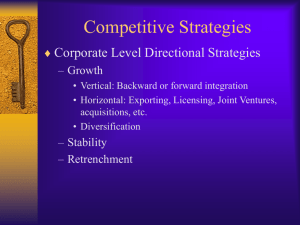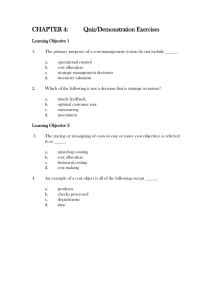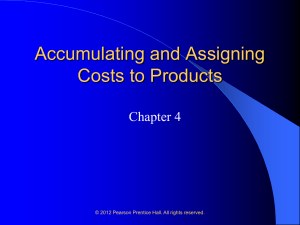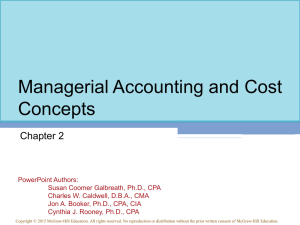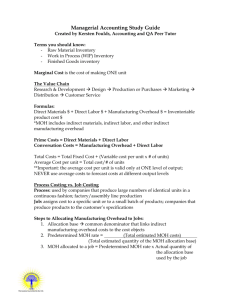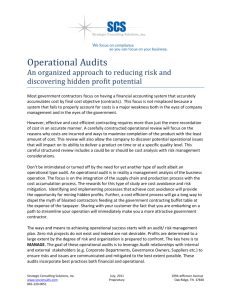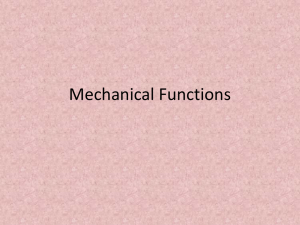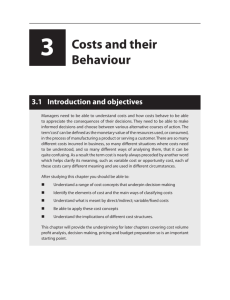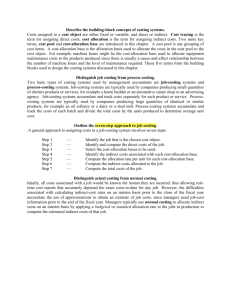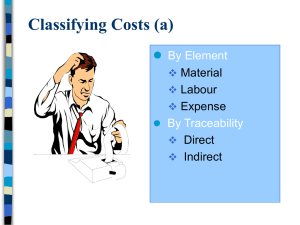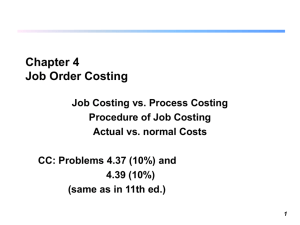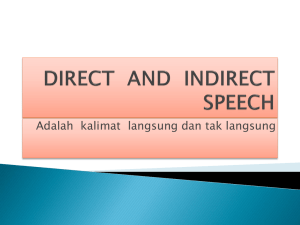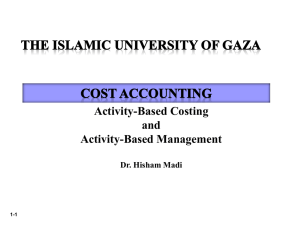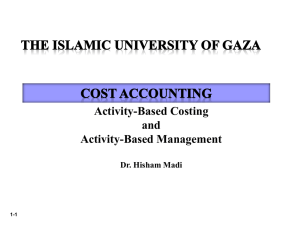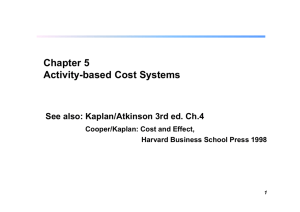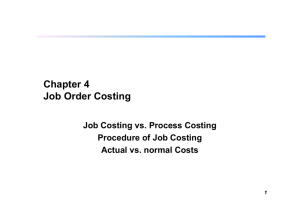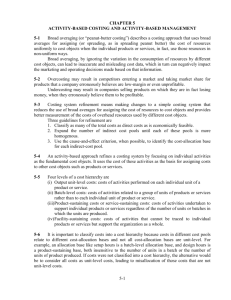Ch4
advertisement
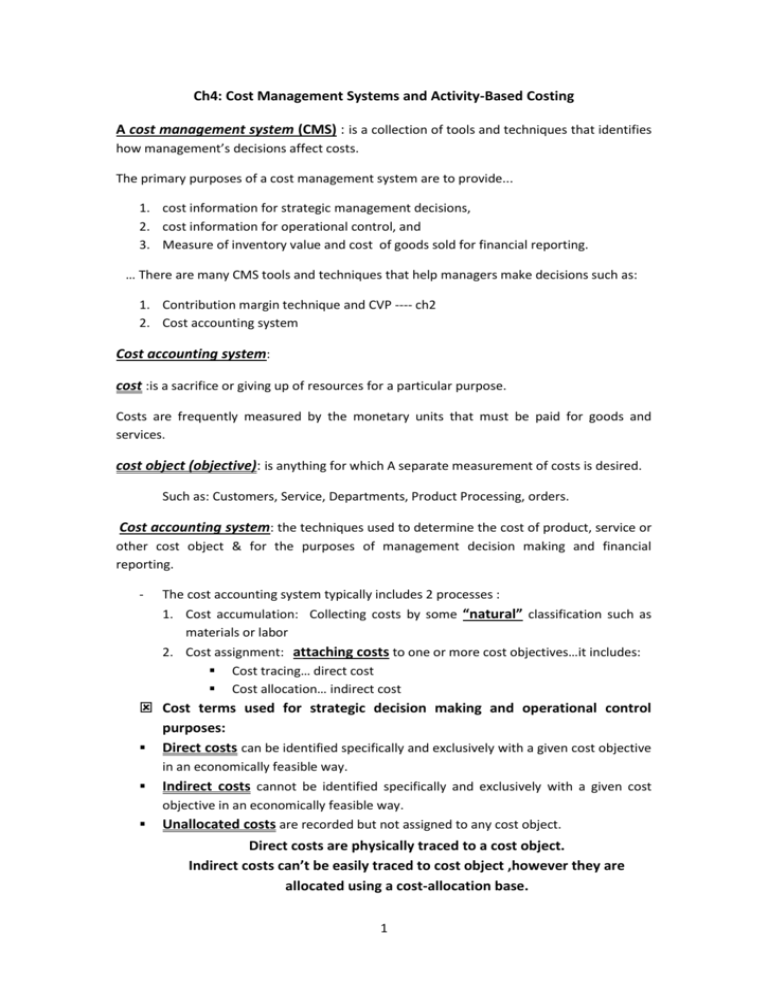
Ch4: Cost Management Systems and Activity-Based Costing A cost management system (CMS) : is a collection of tools and techniques that identifies how management’s decisions affect costs. The primary purposes of a cost management system are to provide... 1. cost information for strategic management decisions, 2. cost information for operational control, and 3. Measure of inventory value and cost of goods sold for financial reporting. … There are many CMS tools and techniques that help managers make decisions such as: 1. Contribution margin technique and CVP ---- ch2 2. Cost accounting system Cost accounting system: cost :is a sacrifice or giving up of resources for a particular purpose. Costs are frequently measured by the monetary units that must be paid for goods and services. cost object (objective): is anything for which A separate measurement of costs is desired. Such as: Customers, Service, Departments, Product Processing, orders. Cost accounting system: the techniques used to determine the cost of product, service or other cost object & for the purposes of management decision making and financial reporting. - The cost accounting system typically includes 2 processes : 1. Cost accumulation: Collecting costs by some “natural” classification such as materials or labor 2. Cost assignment: attaching costs to one or more cost objectives…it includes: Cost tracing… direct cost Cost allocation… indirect cost Cost terms used for strategic decision making and operational control purposes: Direct costs can be identified specifically and exclusively with a given cost objective in an economically feasible way. Indirect costs cannot be identified specifically and exclusively with a given cost objective in an economically feasible way. Unallocated costs are recorded but not assigned to any cost object. Direct costs are physically traced to a cost object. Indirect costs can’t be easily traced to cost object ,however they are allocated using a cost-allocation base. 1 Cost Allocation: is used to assign indirect costs to cost objects, in proportion to the cost object’s use of a particular cost-allocation base. A cost-allocation base: is some measure of input or output that determines the amount of cost to be allocated to a particular cost object. Cost terms used for external reporting purposes: 1. Product costs 2. Period costs Production cost (manufacturing costs, product costs , inventoriable costs) : Costs identified with goods produced or purchased for resale. they become expenses in the form of cost of goods sold only when the inventory is sold. It includes : Direct material: the acquisition costs of all materials that a company identifies as a part of the manufactured goods. These costs are identified in an economically feasible way. Direct labor: the wages of all labor that can be traced specifically and exclusively to the manufactured goods in an economically feasible way. Indirect manufacturing costs (factory burden) or manufacturing overhead : include all costs other than direct materials or direct labor that are associated with the manufacturing process ( ex: power ,supplies , indirect labor , rent , depreciation , …) Period costs (operating expenses, selling and general administrative expenses): Costs that are deducted as expenses during the current period without going through an inventory stage. Traditional and activity-based-accounting systems Traditional costing systems: often use only one cost driver for all indirect manufacturing costs and don’t attempt to identify, accumulate, or report costs by activities performed. Activity- based accounting (ABA) or activity-based costing (ABC) systems: a system that first accumulate overhead costs for each of the activities of an organization, and then assign the costs of activities to the products, services, or other cost objects that caused that activity. Cost drivers are identified for each activity to establish a cause – effect relationship between an activity and a cost driver. 2 Because ABC focus on activities, they are very useful tool in : Cost management system Benchmarking Activity – based management: a cost management system tool Using the output of an activity –based cost accounting system to aid strategic decision making and to improve operational control of an organization. - the most useful applications of ABM is distinguishing value added costs and nonvalue added costs: value-added cost: is the cost of an activity that cannot be eliminated without affecting a product’s value to the customer(necessary). nonvalue-added costs: are costs that can be eliminated without affecting a product’s value to the customer. such as handling and storing inventories, transferring partly finished products from one part of the plant to another… accompany can often Benchmarking: it is the continuous process of comparing products, services, and activities to the best industry standards it is a tool to help an organization measure its competitive posture. 3
